If you’ve ever felt like your garden is a bottomless pit of endless watering and maintenance, you’re about to discover your horticultural salvation. Drought-resistant plants aren’t just water-wise choices – they’re your ticket to a stunning, low-effort landscape that practically takes care of itself. From the feathery plumes of Purple Fountain Grass to the silvery spires of Russian Sage, these resilient performers will transform your garden into a self-sufficient oasis that thrives while your water bill shrinks.
Contents
Purple Fountain Grass
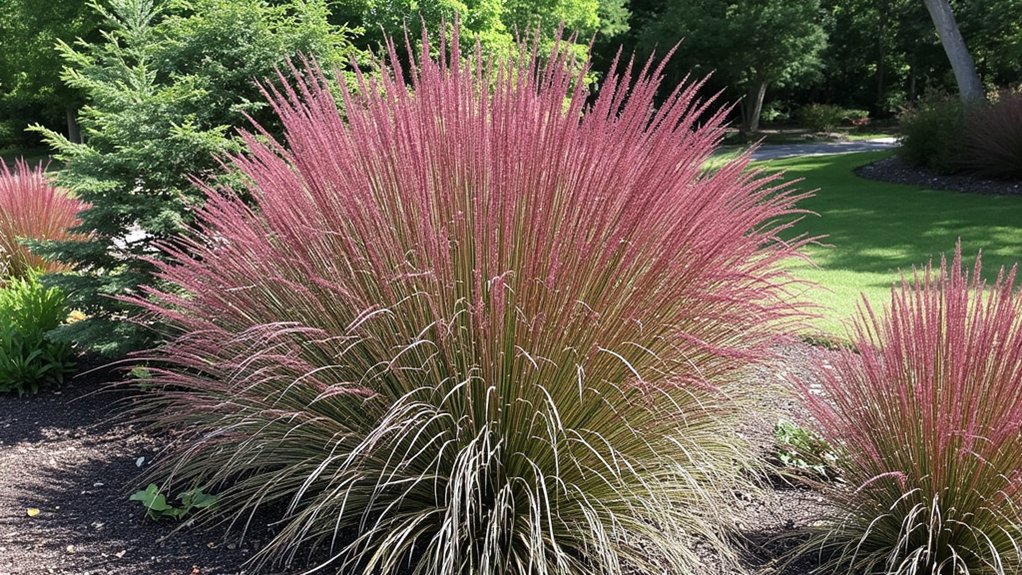
A graceful cascade of burgundy plumes makes Purple Fountain Grass (Pennisetum setaceum ‘Rubrum’) one of the most striking ornamental grasses for drought-tolerant gardens. You’ll find this perennial grass grows quickly to 3-5 feet tall, creating dramatic height and movement in your landscape.
Plant your Purple Fountain Grass in full sun, spacing plants 24-36 inches apart to allow for their arching form. You won’t need to water established plants more than once every 7-10 days, even during hot summers.
In zones 9-11, your grass will remain evergreen year-round. If you’re in cooler regions, cut the foliage back to 6 inches in late winter before new growth emerges. For container planting, choose a pot that’s at least 18 inches wide to accommodate the plant’s extensive root system.
Aromatic Russian Sage
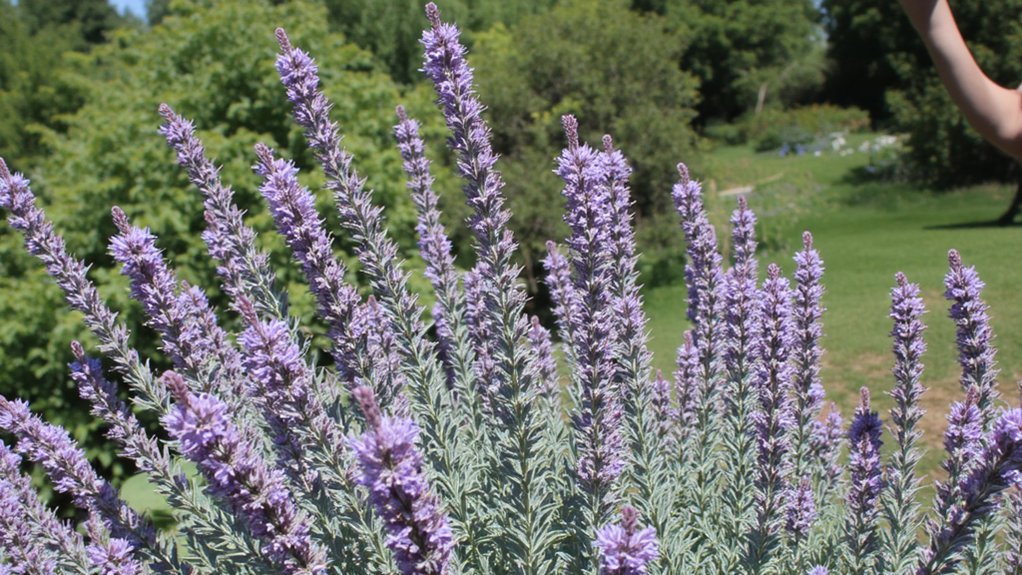
Tall spikes of lavender-blue flowers make Russian Sage (Perovskia atriplicifolia) an eye-catching addition to any drought-resistant garden. This hardy perennial reaches heights of 3-5 feet and spreads 2-3 feet wide, creating a soft, silvery presence in your landscape from mid-summer through fall.
You’ll find Russian Sage incredibly easy to maintain, as it thrives in full sun and poor soil conditions. Once established, it needs minimal watering and actually performs better without frequent irrigation. For best results, plant it in well-draining soil and space plants 24 inches apart.
In late winter, cut the stems back to about 6 inches above ground level to promote vigorous spring growth. You’ll notice the aromatic silver-gray foliage emerges early, followed by months of delicate purple blooms that attract butterflies and bees.
Drought-Tolerant Sedum
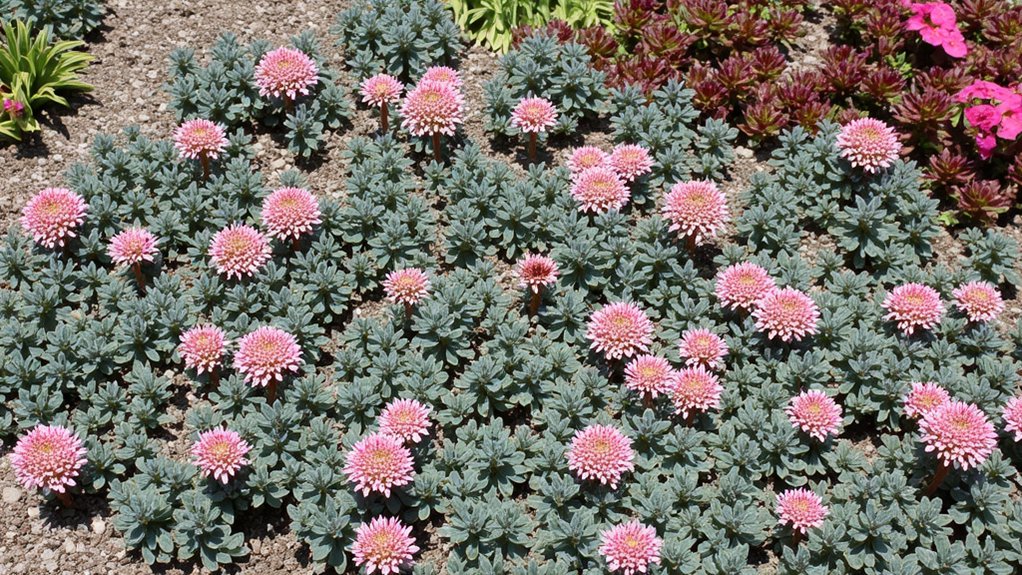
Because of their thick, succulent leaves and sprawling growth habit, Sedum varieties rank among the most versatile drought-resistant plants you’ll find. You’ll discover dozens of options, from low-growing stonecrop that reaches just 3 inches tall to upright autumn joy that towers at 24 inches.
These hardy perennials thrive in well-draining soil and full sun, though they’ll tolerate partial shade. Plant your sedums 12-18 inches apart in spring, and you won’t need to divide them for at least 4-5 years. They’re particularly useful for rock gardens and border edges.
While most sedums produce clusters of tiny pink or white flowers, it’s their fascinating foliage that steals the show. You’ll see colors ranging from blue-gray to burgundy, often changing hues as seasons progress.
Spreading Lantana
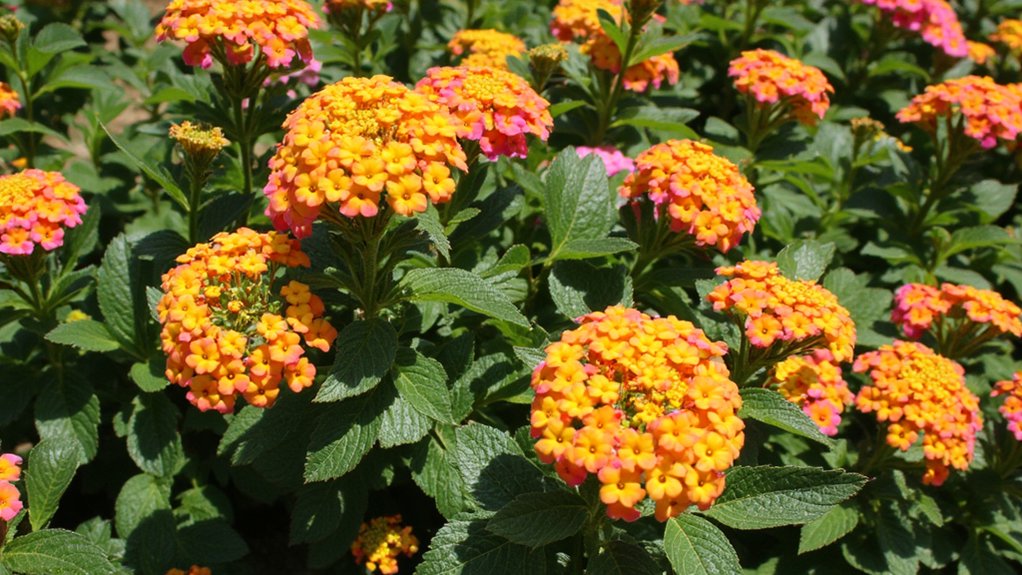
Spreading lantana delivers spectacular clusters of multi-colored blooms while laughing in the face of drought. You’ll find this hardy perennial thriving in USDA zones 8-11, where it’ll spread 3-6 feet wide and grow 2-4 feet tall in full sun conditions.
Plant your lantana in well-draining soil during spring, spacing plants 3 feet apart to accommodate their spreading nature. Once established, they’ll need minimal watering, typically just once every 7-10 days during extreme heat.
You’ll enjoy continuous blooming from late spring through fall, with flowers evolving through shades of yellow, orange, pink, and purple as they mature. Trim back the stems by one-third in early spring to maintain shape and prevent woodiness, and remove spent blooms to encourage more flowering.
Spiky Desert Yucca
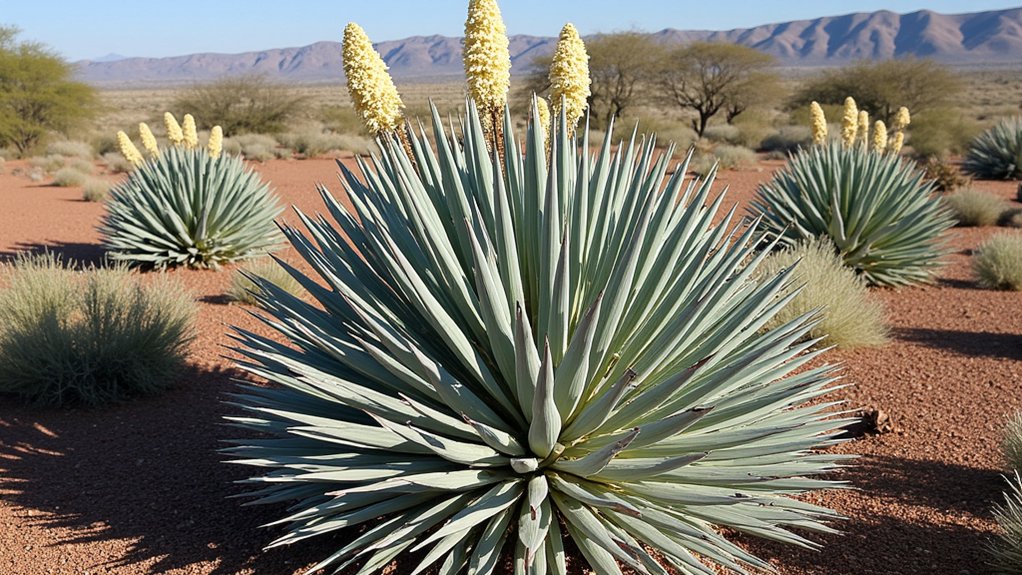
Desert yucca adds striking architectural drama to any drought-resistant landscape with its sword-like leaves and towering flower spikes. You’ll find these hardy succulents thrive in USDA zones 5-10, requiring almost no maintenance once established. Their distinctive rosettes can grow 2-3 feet wide, while flower stalks often reach 3-6 feet tall.
Plant your yucca in well-draining soil where it’ll receive at least 6 hours of direct sunlight daily. You won’t need to water established plants except during prolonged droughts, making them perfect for xeriscaping projects.
These architectural plants are deer-resistant and can live for decades. For the best results, space multiple yuccas 4-6 feet apart to create dramatic focal points, or use them as protective barriers along property lines where their spiky leaves serve double duty.
Sturdy Blue-Green Agave
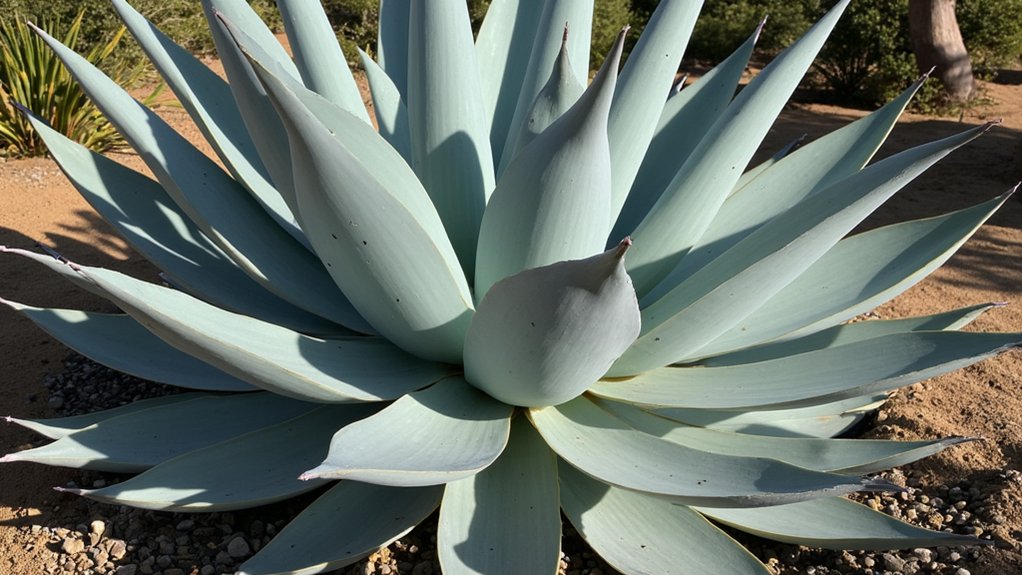
The statuesque blue-green agave stands as a natural sculpture in drought-resistant gardens, combining bold architectural form with remarkable durability. You’ll find these succulent powerhouses growing up to 6 feet wide, with thick, pointed leaves that create a perfect symmetrical rosette pattern.
When you’re planting agave, choose a spot with well-draining soil and full sun exposure. They’ll thrive in zones 8-11, where temperatures rarely dip below 20°F. You won’t need to water established plants more than once every 2-3 weeks, even during summer’s heat.
Remember to wear thick gloves when handling agave, as those striking leaf tips are seriously sharp. With proper placement and minimal care, your agave will serve as a striking focal point for 15-20 years before flowering just once in its lifetime.
Colorful Mexican Sunflower
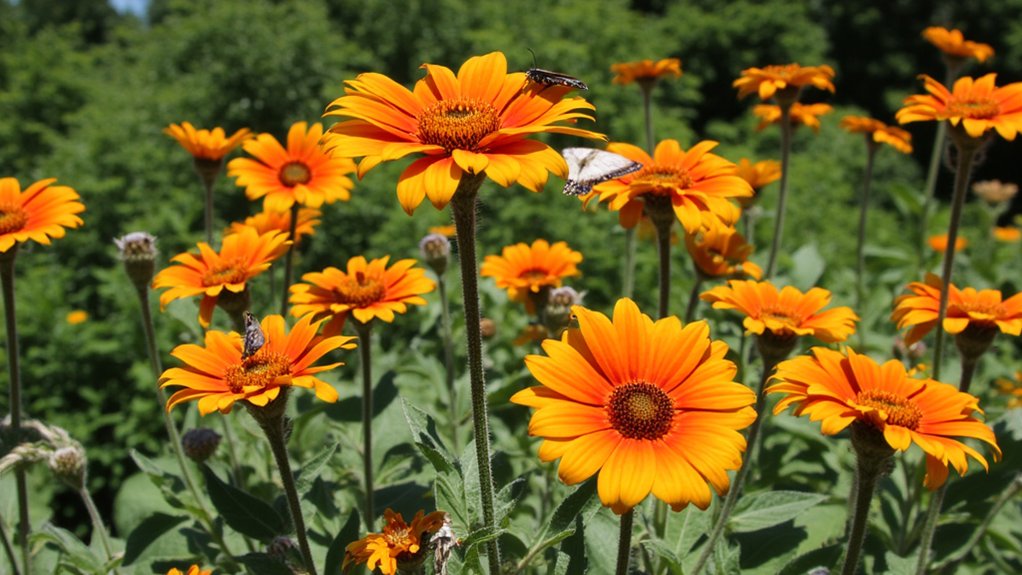
Vibrant Mexican sunflowers bring bursts of fiery orange-red blooms to your drought-resistant garden from midsummer through fall’s first frost. These hardy annuals, growing 4-6 feet tall, thrive in full sun and can handle poor, sandy soil with minimal water once established.
You’ll want to sow seeds directly in the ground after your last spring frost, spacing them 2-3 feet apart. They’ll germinate within 7-14 days and don’t require fertilizer to produce their striking daisy-like flowers.
Mexican sunflowers attract pollinators like butterflies and hummingbirds while deterring deer and rabbits. For continuous blooming, deadhead spent flowers regularly, and you’ll enjoy these show-stopping plants until temperatures dip below freezing. They’re also excellent cut flowers, lasting up to a week in vases.
Hardy Blanket Flower
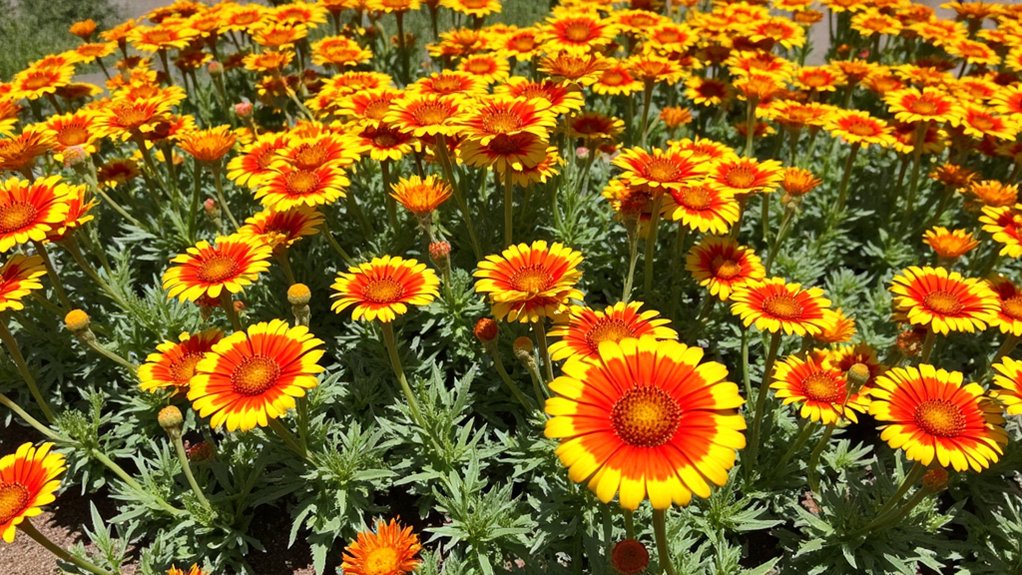
Prolific blanket flowers offer year-round bursts of red, orange, and yellow daisy-like blooms while thriving in hot, dry conditions. You’ll find these hardy perennials, known botanically as Gaillardia, growing naturally in meadows and prairies across North America, where they’ve adapted to survive with minimal water.
Plant your blanket flowers in well-draining soil, spacing them 12-15 inches apart in full sun. They’ll reach heights of 2-3 feet and spread just as wide, creating dense mounds of finely cut foliage. You won’t need to deadhead these low-maintenance beauties, as they’re self-cleaning.
For best results, water your blanket flowers deeply once every 7-10 days during their first growing season. After establishment, they’ll only need supplemental water during extreme drought conditions, making them perfect for xeriscaping.
Red-Hot Egyptian Star Flower
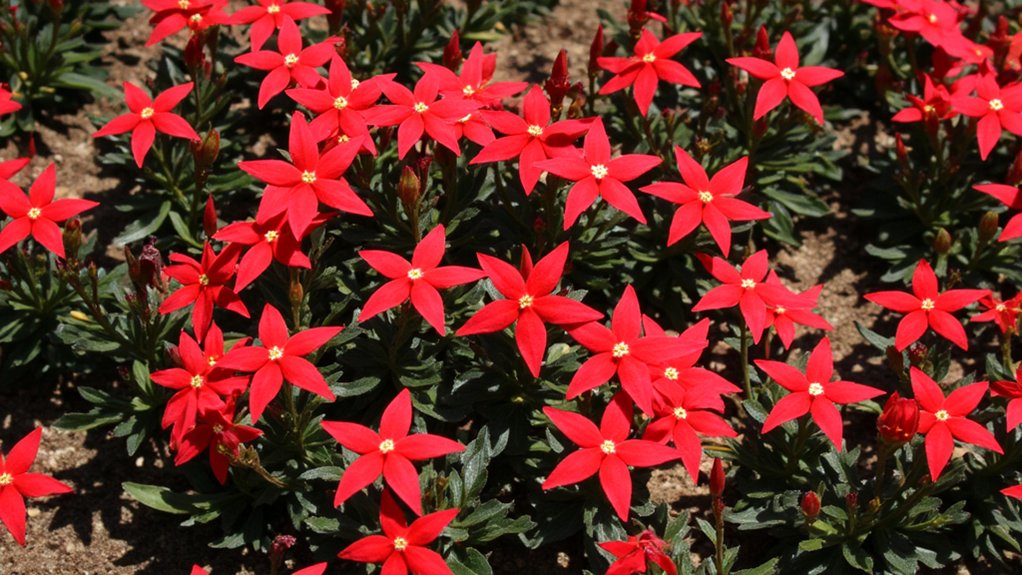
Spectacular star-shaped blooms make Egyptian star flowers a standout choice for drought-resistant gardens. You’ll love how these resilient plants produce vibrant crimson flowers, each measuring 2-3 inches across, from late spring through early fall. Once established, they’ll thrive in full sun with minimal watering, making them perfect for xeriscaping.
Plant your Egyptian star flowers 12-18 inches apart in well-draining soil, and you’ll see them reach heights of 24-36 inches within their first growing season. They’re particularly suited for USDA zones 9-11, where they’ll perform as perennials. In colder regions, you can grow them as annuals or bring them indoors during winter months.
These low-maintenance beauties don’t require deadheading, though you can trim them back by one-third in late summer to encourage a second flush of blooms.
Resilient Lavender Cotton
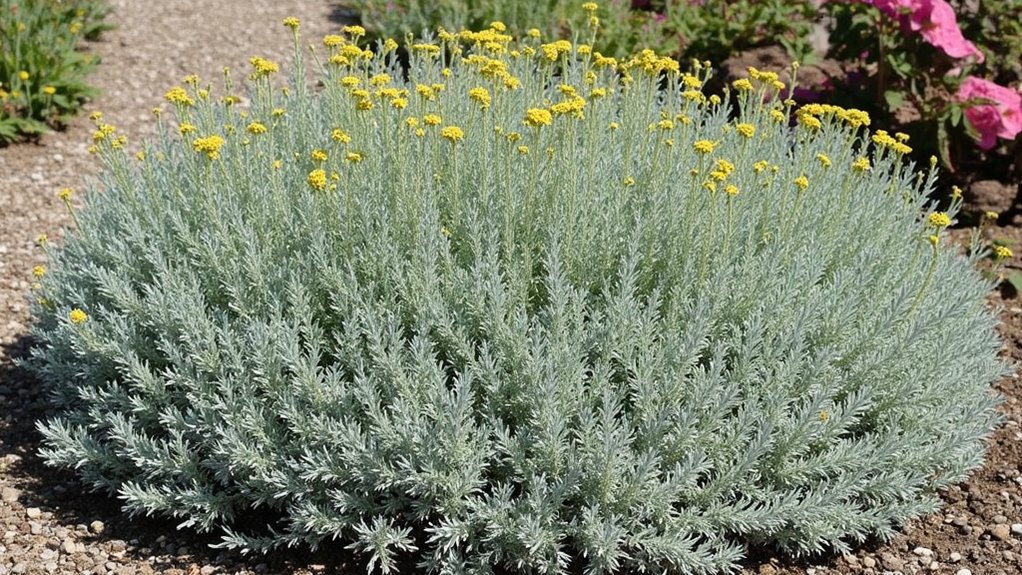
With its silvery-gray foliage and compact growth habit, Lavender Cotton stands as one of the most adaptable plants for drought-prone gardens. You’ll find this Mediterranean native thriving in USDA zones 6-9, where it forms neat mounds reaching 1-2 feet in height and spread.
Plant your Lavender Cotton in well-draining soil with full sun exposure, spacing plants 18 inches apart. Once established, you’ll only need to water it every 2-3 weeks during the growing season, making it perfect for xeriscaping projects.
To maintain its shape, trim back the stems by one-third in early spring, and remove spent flower heads in late summer. You can expect yellow button-like blooms from June through August, though many gardeners grow it primarily for its attractive foliage and architectural form.
